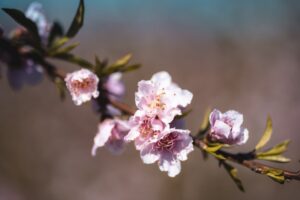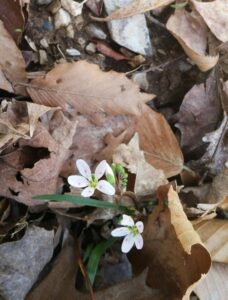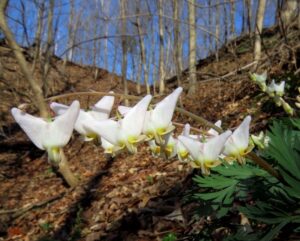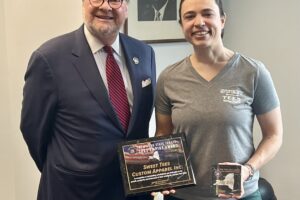
February is when winter begins to fade ever so slightly. The shelves are stocked with Valentine’s Day cards and chocolates. Phil makes an appearance, and we all watch closely to see if the groundhog sees his shadow. Whatever the outcome, spring is not here yet; we just need to wait until March 20th.
But lo and behold, a few of our native spring ephemerals start appearing. A few magical flowers burst open as early as February, when the sun can reach them on the forest floor before the trees start leafing out.
Spring ephemeral season starts in February and goes through May. The flowers are short-lived and vanish quickly. I recommend taking a walk in one of Westchester’s many nature preserves and trying your luck spotting them (but not pulling them). Here’s a few of my favorite ephemerals that flower in this region to keep watch for.

Spring Beauty (Claytonia virginica) – Flowers February through April
This pinkish-white, star-petaled spring beauty can sometimes flower as early as February and it lasts for just one week, so keep your eyes peeled. The flowers wait to open until the native solitary bees are ready. In particular, the miner bee will only collect pollen from the spring beauty; it can only feed off of this one plant. And it lays its eggs on this one plant. This is an example of a specialist plant-animal relationship, developed over thousands of years as the two species have interacted and lived within the same habitat. It highlights how important native plants are and their role in a biodiverse food web.

Skunk Cabbage (Symplocarpus foetidus) – Flowers February through April
Skunk cabbage is my absolute favorite ephemeral. I love the provocative shape of the skunk cabbage bloom. And the fragrance is so unique that when it first flowers in the spring I just have to stop and take it in. The mottled purple-red flower curls out with a spike in the middle. Beetles and flies are the primary pollinators of skunk cabbage, which is why it emits a pungent smell of carrion. Somehow the cabbage produces its own heat, hot enough to create flower buds as warm as 70 degrees, melting any snow around it. Next time you are walking near a wetland or a stream, keep your eyes and nose out.

Dutchman’s Breeches (Dicentra cucullaria) – Flowers April through May
The most adorable spring ephemeral is Dutchman’s Breeches. The little white pants appear to walk up and down the central stem. Within each of the pair of breeches is a nectar treat that only long-tongued bees, like bumble bees, can access. Here is another specialist relationship where the flower has co-evolved with one type of bee, and it’s the only animal that can pollinate Dutchman’s Breeches. The plant is toxic to many mammals, including deer, and is a great addition to a moist, dappled-shade garden. They flower close to the ground for 2-3 weeks so be sure to spot them before they disappear and “walk away.”
Our native spring ephemerals are precious and help showcase the look and function of a biodiverse landscape.. While the flowers are each gorgeous and incredibly unique, behind the scenes there is an intricate set of ecosystem relationships, such as the spring beauty blooming in time for the miner bee to pollinate it. By planting native in our yards, we can help to support a diverse and naturally beautiful ecological web.
Amanda Bayley is the CEO & Co-Founder of Plan it Wild, a sustainable land management company that is bringing back native habitats to Westchester yards.
More Nature. Now. www.PLANitWILD.com






